Please read the Workshop Reflections blog post before reading this. https://pgcertiplum.myblog.arts.ac.uk/2023/11/08/project-findings/
In the first two workshops I embedded formative feedback exercises to work on the challenge of verbalising sensory experiences as part of participatory data analysis and facilitating feedback from participants to have enough data, this is a known concern when gathering feedback for sound workshops as it is a physical, intangible experience of the senses.
Participatory Thematic Data Analysis
At the end of the first workshop, I asked participants to write their responses to working with the score by Annea Lockwood, asking a series of questions as prompts to build a network of answers that related to each other. My questions related to the experience of participants in following the score, which uses text and audio recordings to transmit the concept of the performance to participants. This combination of audio and text as a musical score was seen by most participants as being more accessible than classical musical notation. I also asked them their experience of the physical warm up exercises and the combination of vocal exercises with physical movement, this was harder for most to articulate as is often the case with both sound and physical experience, as they are both non-verbal sensory experiences. The use of large drawing paper, coloured pens and group discussion proved helpful to participants for verbalising and writing down their feedback, in particular finding a variety of wording for my questions was required to prompt responses from different people.
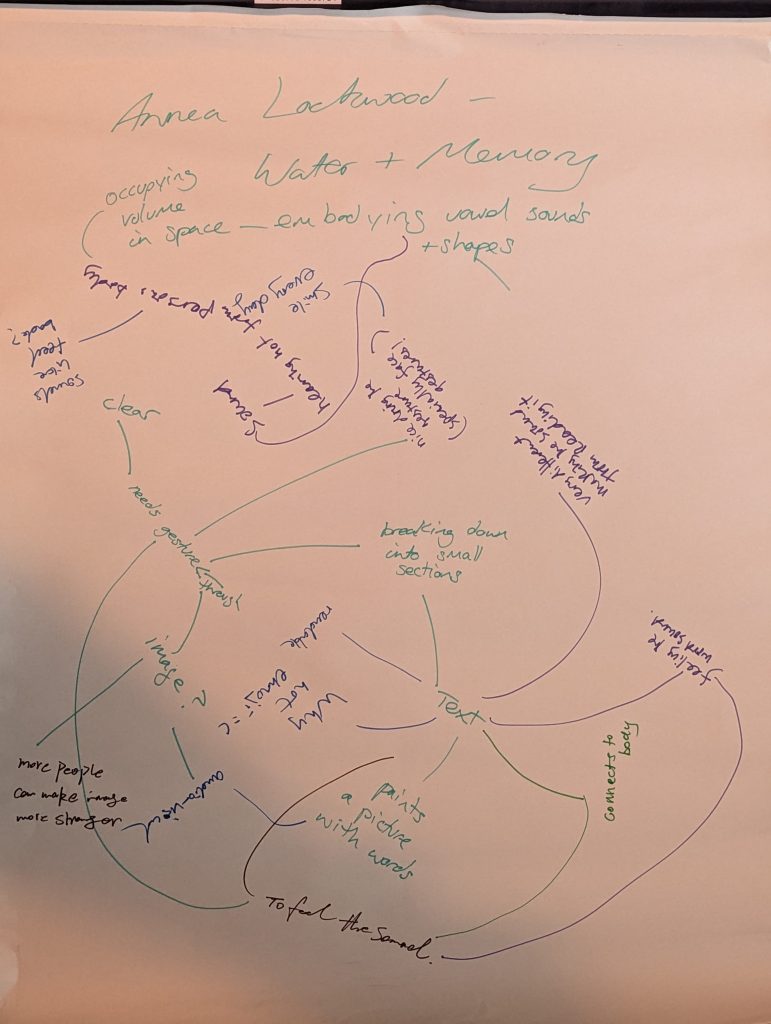
Reflexive Thematic Analysis
At the end of the second workshop I asked participants to engage in reflexive thematic analysis by prompting them to complete each section of an ‘exquisite corpse’ paper.
This anonymised feedback whilst still allowing for the community aspect of participatory group feedback. It allowed me to repeat the wording of questions and support feedback with differentiation, with participants encouraged to contribute as part of a group activity which was the last exercise in the workshop. Compared to the previous workshop and feedback activity, this game as feedback activity meant that each participant answered each question in order for the game to continue, resulting in equal amount of feedback and data from each participant.
This created more data for analysis than the previous workshop feedback. The results were more abstract, as this game is often used to write poetry or short stories, and so poetic, interpretive and metaphorical language was used to express the ideas around sound especially by those familiar with the game. Again, this was an approach to the challenge of qualifying data from experiential learning, forming text data from sensory experiences such as listening, singing, stretching, moving and walking. Being anonymous seemed to allow participants to express more creatively their experience of singing and using their voice. The prompt questions (see Project Findings blog post) were also refined from my own experience of providing prompts for the previous workshop feedback, and so I created a step by step layering of questions to support feedback in stages from external to more internal experience. This approach of stages allowed for participants to practice, or get the hang of, the exercise in order to feel more comfortable describing sensory experience and internal responses to external stimuli. The anonymity also increased the length of responses, enabling participants to find their own language and metaphors.
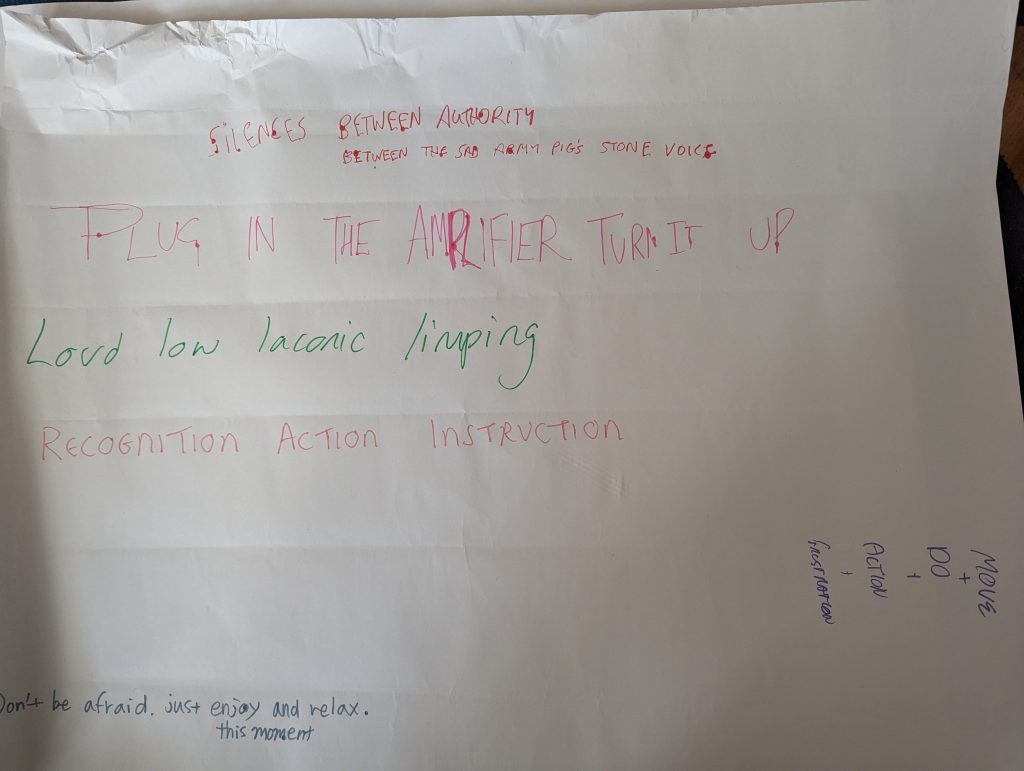
Reflexive Thematic Analysis
For the 3rd workshop, I posed questions relating to spaces and where participants would feel most comfortable using their voice. I asked them to use their imaginations and the prompts I gave them took the form of a guided visualization. I asked them to write directions on the cards to be used by others as part of a tarot style deck of cards. Using a guided visualization process as a framework for prompts worked well in terms of focusing on the reflexive nature of thematic analysis, and in terms of allowing participants voices to be foremost when writing their cards. This was supported by prompting participants to approach writing the cards as a form of free writing, without editing or judgement. The visualisation framework fitted well as a follow on from the activities of the workshop, and this was the most seamless transition into data collecting. The internal nature of the guided visualization supported participants in finding vocabulary for their own specific needs in terms of what they see as a safe space for using their voice. This, along with the wordcloud in the final survey, was the most successful in finding ways to verbalise the invisible process of sound, and sounding with one’s own voice. The prompts focussed on the ways in which we can feel more comfortable using our voice, not only in terms of environment but in our approaches to voice and vocalising. In turn, these cards can support others to consider ways in which to use their voice as a potential resource in future. Again this was anonymous, something I continued in each stage of data collection after observing the self-consciousness of participants in the first workshop.
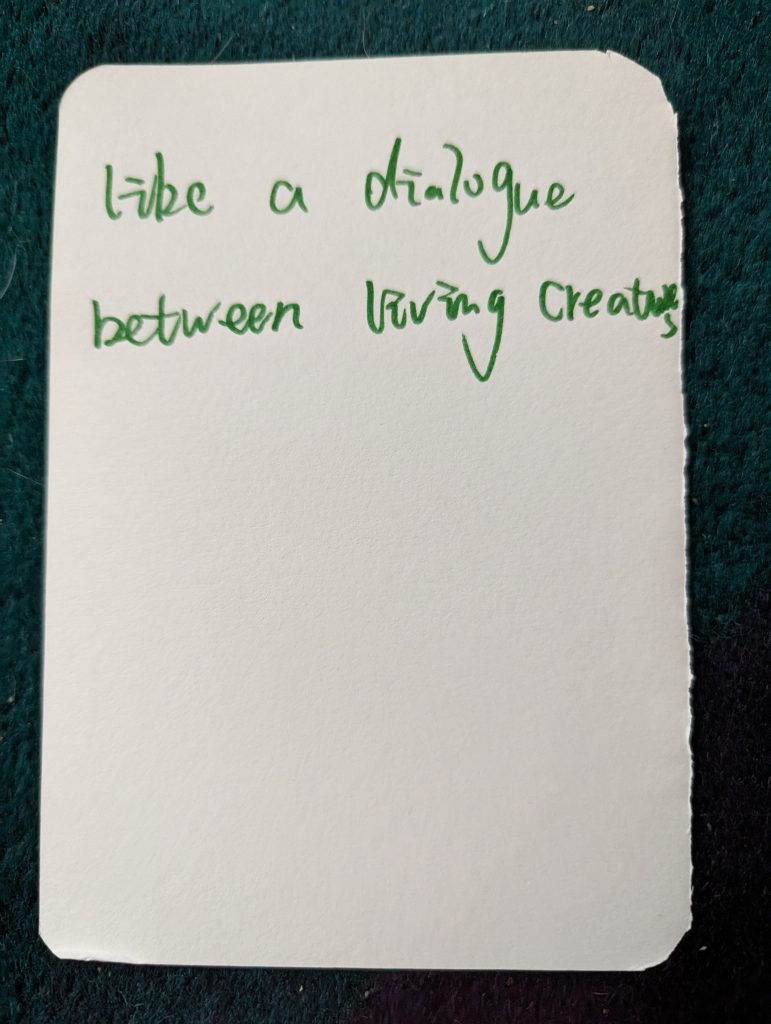
Thematic Analysis
I chose thematic analysis as this project required the drawing together of different threads in concepts on sound, in such a wide variety of approaches in a fairly open subject matter such as the voice and sound, which thematic analysis enables. Thematic analysis allows for the gathering of data, identifying themes and pinning down the question prompts in each phase of data collection ro gain individual answers on internal, invisible and intangibe processes in sounding the voice and experiencing sound.
For the last workshop I designed a presentation that could be anonymously completed as a feedback survey via mentimeter. This would have been the penultimate exercise in the last workshop, the final exercise would have been a soundscape composition as a form of participatory data art. I wanted participants to have creative control over how their own feedback data was collected and represented artistically. Mentimeter is a website that allows participants to follow along a presentation and respond to questions and prompts on their phone, with data then appearing as results according to which template you choose. The first page contained the htree questions for my Action research project to gain insights into the use of the voice and whether extra-curricular workshops like the experimental choir could facilitate students to use their voice more. I also wanted to know if it had an impact on their sense of wellbeing.
Participant view of survey:
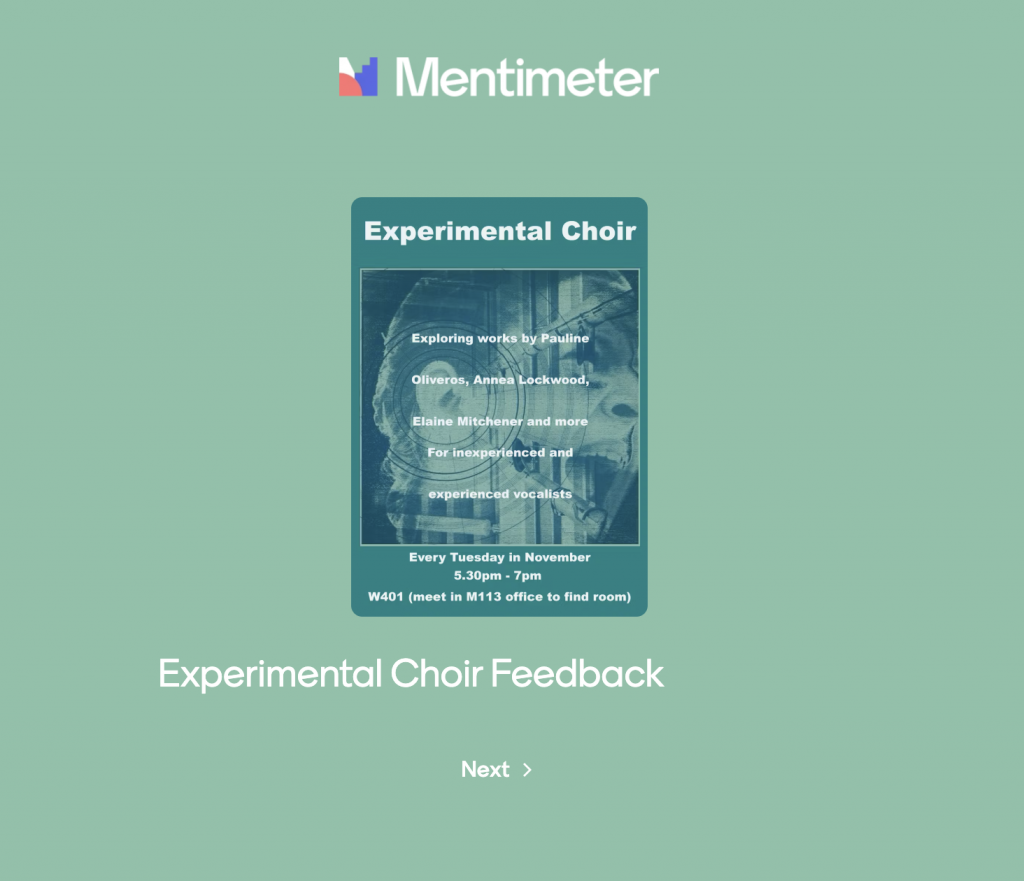
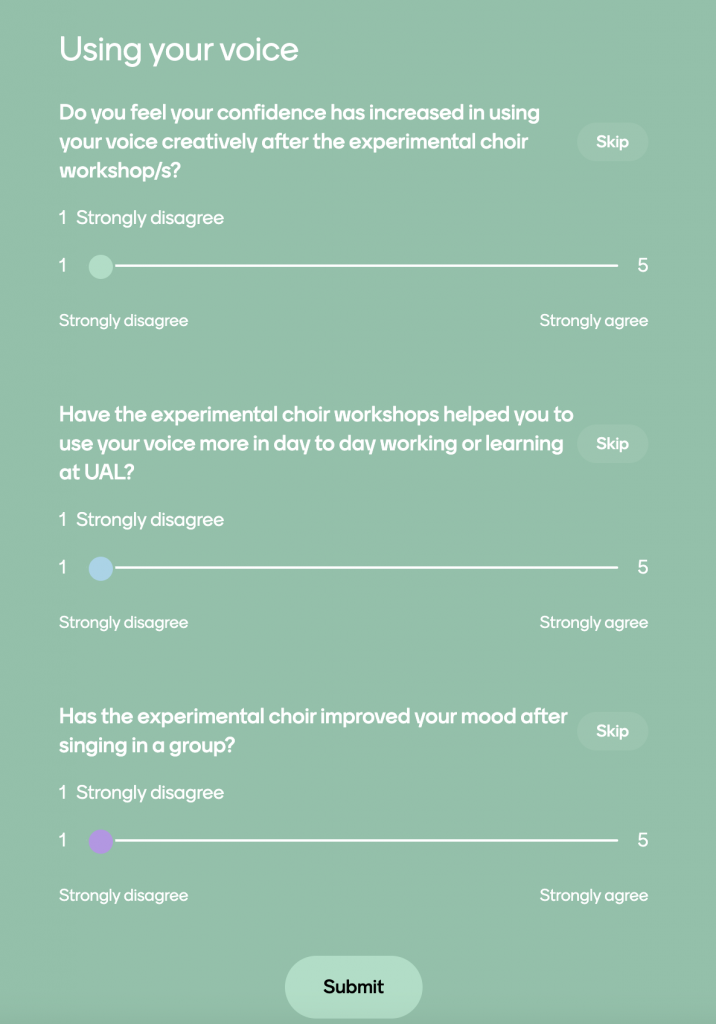
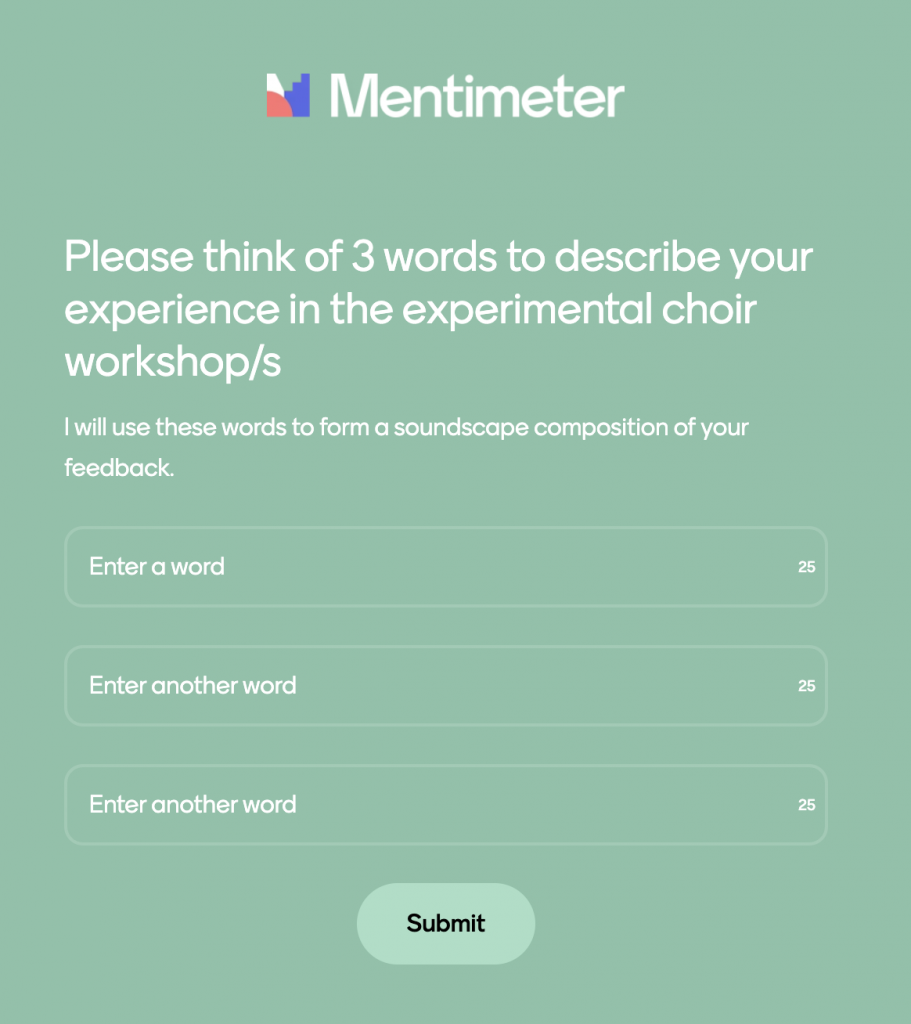
Results – 6 responses
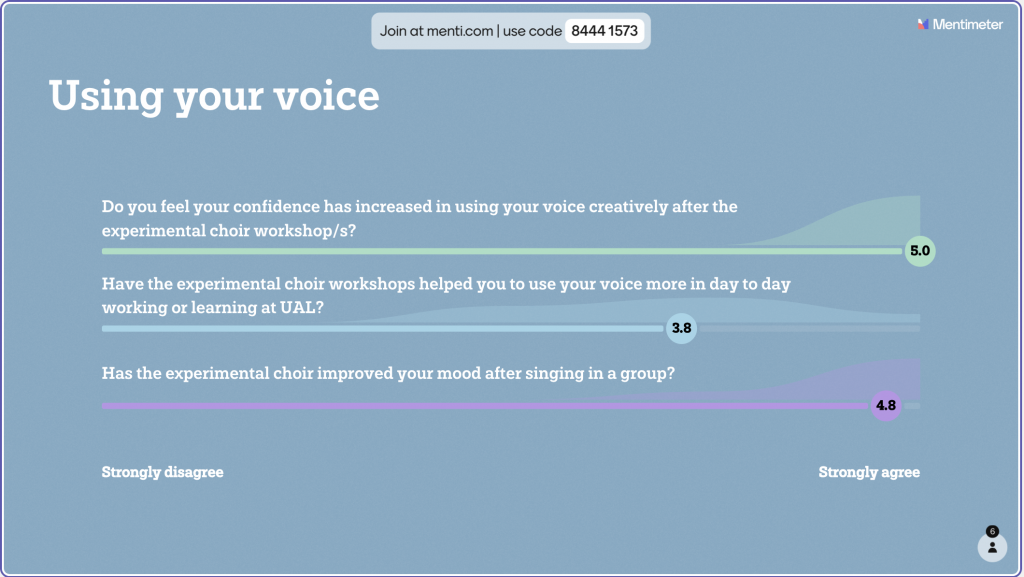
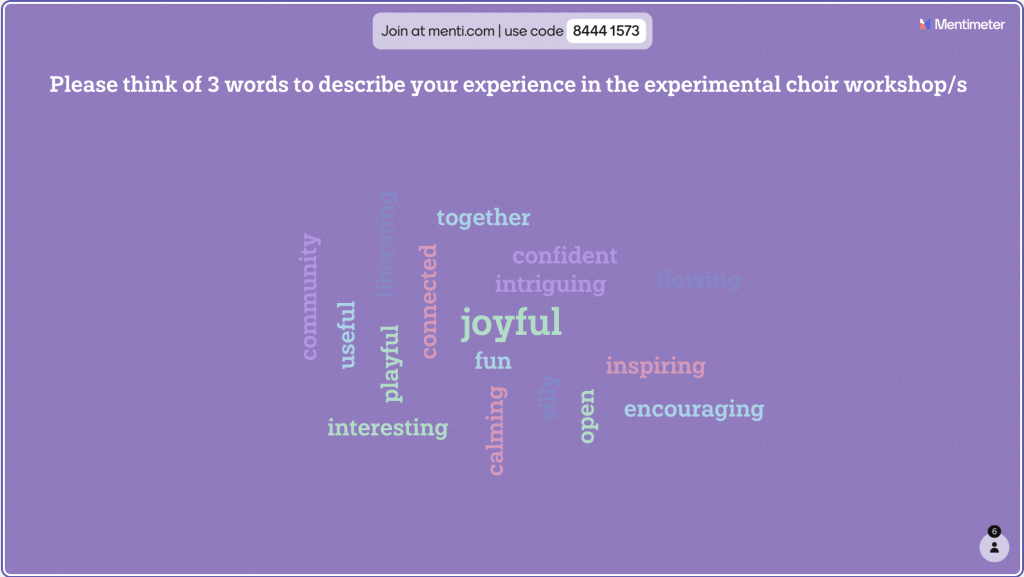
Participatory Data Art
The second page in the survey asked them to contribute words to describe their experience of the workshops as a whole series, in the form of a word cloud. The aim was to use these words, and follow the feedback survey presentation activity with a longer improvisation activity, using the words to form a soundscape interpreting the data as a group artistic data sonification. This would have allowed participants to have creative control over the representation of their data in participatory data art.
Unfortunately, due to unforeseen building closures I wasn’t able to run the last workshop, it was the end of term and couldn’t be rescheduled. Instead, I had to send the Mentimeter survey as an online survey that participants could complete remotely.
Below you can hear an example of another soundscape workshop I ran for the NHS with participants experiencing mental health difficulties. This uses a similar activity to the one I had planned for the final workshop, where participants contributed words, and we explored the sounding of these words with the voice. This activity as a method of data evaluation would have allowed participants to suggest creative presentations of the sonification of the data, resulting in a group composition of a word based vocal soundscape.

In terms of data analysis, this would have been an interesting experiment in further exploration of the verbalisation of sensory experience, by returning to the activity of singing to explore the sonic properties of the data, the words. It would have been a way to analyse data within the medium used for the collection of the data,. It would have allowed participants to have creative input into how their data was expressed, and this would have been recorded as an improvised performance. Instead of the arbitrary nature of sonifying data that I have observed in sound art trends in recent years, this process would have allowed participants to choose how to sonify their own data, and how to embody that data as sound.
I became interested in finding a creative approach to evaluating data that adhered to the rigorous ethics outlined in the previous modules, after researching the methods of Ann Light, in particular ‘Creative Evaluation Methods for Artistic Practice and Cultural Transformation (with lessons learned from CreaTures)’. Light states “Evaluation is often undertaken with a heavy heart. Is this because the purpose is usually to meet others’ agendas?”
Light goes on to ask:
● How can evaluation be made to serve creative interests?
● How can it be incorporated into creative work?
● And how can it be designed to respond to the special qualities that creative practice brings?
Her CreaTures Framework (https://creaturesframework.org/) is proposed as “a tool for reflection and the basis for thinking about our needs with regard to assessment.”
As a researcher, I found this an exciting idea to create an activated sonic document of data rather than an archival document. Action Research within creative disciplines seems to be held to parameters for analysis that are based on frameworks created within very different disciplines, such as scientific disciplines. How do we, as researchers, analyse data collected through creative practice that adhered to discipline relevant parameters, whilst elevating our research to be considered equally alongside other disciplines? It reminded me of the process the research unit I am attached to went through, where sound as a research area was measured by visual arts parameters. In the evaluation for this action research project, the parameters for the evaluation would be using the same framework as the creative practice being evaluated, thereby making the parameters fit the medium rather than the medium fit other parameters designed for a different medium.
After I was unable to deliver the last workshop and had to get the survey completed via a link sent out to participants, I considered recording it myself. I decided that this would give only myself creative control over how the data was expressed and this would defeat one of the purposes of this method of data representation, in turn creating an ethical conflict for myself as a researcher with a duty to represent the data collected in a way that reflects the interests of the stakeholders. The words exist as an evaluation of the immediate impact of the workshop, and the quantifiable number scales on the previous slide allow for a measurement of the lasting impact on their creative practice and ability to use their voice in university.
The issue of creative control is a revealing lens to evaluate this data, as the numbers are slightly lower for the second question which relates to using the voice more generally in university life. The questions related to creative practice scored highly universally, indicating that where students have creative control there was more scope for development of the use of the voice following the workshops. The use of the voice more generally in university life is more complex with barriers beyond the control of the participants, and so this could be why participants did not find as high results on this question. This question could be expanded upon in further research to identify the ways in which students and staff struggle to use their voice in university life, however the focus of this project was to empower, facilitate and build skills in using the voice. These survey results show that, in the limited time available for this project on this scale, it has successfully found ways in which we can support students to use their voice at university, through extra-curricular activities.
Please read the Presentation and Project Findings posts: